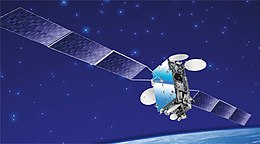cosmos.wikisort.org - Spacecraft
ChinaSat 12 (Chinese: 中星12号; pinyin: Zhōngxīng 12)[4][5][3][6] communications satellite is wholly owned by China Satellite Communications, with part of its communications payload leased or rented by SupremeSAT, a Sri Lankan company to be marketed to potential users as SupremeSAT-I.[7] Once operational, it will provide communications services for the China, Sri Lanka, East Asia, South Asia, Middle East, Africa, Australia and China sea area, the Indian Ocean region.[8]
 Illustration of ZX 15A | |
| Mission type | Communication |
|---|---|
| Operator | China Satellite Communications |
| COSPAR ID | 2012-067A |
| SATCAT no. | 39017 |
| Website | english |
| Mission duration | 15 years |
| Spacecraft properties | |
| Bus | Spacebus-4000C2[1] |
| Manufacturer | Thales Alenia Space |
| Launch mass | 5,054 kilograms (11,142 lb) |
| Power | 2 deployable solar arrays, batteries |
| Start of mission | |
| Launch date | 27 November 2012[2] |
| Rocket | Long March 3B/E[3] |
| Launch site | Xichang LA-2 |
| Orbital parameters | |
| Reference system | Geocentric |
| Regime | Geostationary |
| Longitude | 87.5° East |
| Transponders | |
| Band | 28 C-band 28 Ku-band |
| Coverage area | China Sri Lanka East Asia South Asia Middle East Africa Australia China sea area the Indian Ocean region. |
ChinaSat 12 was also known as Apstar 7B (as a backup of Apstar 7), but acquired by China Satellite Communications from its subsidiary APT Satellite Holdings in 2010.[9] However, APT Satellite Holdings was contracted by its parent company as the operator of ChinaSat 12.[9]
Orbit
Following launch on 27 November 2012,[10] the satellite was placed into geosynchronous orbit and located at 51.5° East while being tested. On April 19, 2013, it started to move towards its operational location at 87.5° East.[citation needed]
The satellite was built by Thales Alenia Space and has a designed life of 15 years.
Gallery
 Diagram of the Long March 3B, showing its outboard liquid rocket boosters.
Diagram of the Long March 3B, showing its outboard liquid rocket boosters.- The launch of a Long March 3B (similar to CZ-3B/E (Chang Zheng-3B/E))
References
- http://space.skyrocket.de
- http://www.satlaunch.net
- http://www.satbeams.com
- "中星12号" (in Chinese). China Satellite Communications. 2 December 2014. Retrieved 25 July 2017.
- "ChinaSat 12" (in Chinese). China Satellite Communications. 27 May 2015. Retrieved 25 July 2017.
- Chinasat-12 ex-Apstar 7b footprints
- Supreme Group pioneers Sri Lanka’s space industry Archived 2012-11-28 at the Wayback Machine
- Krebs, Gunter. "ZX 12 (ChinaSat 12, SupremeSat 1)". Gunter's Space Page. Retrieved 22 November 2012.
- "關連交易" (PDF) (Press release) (in Chinese). APT Satellite Holdings. 25 September 2012. Retrieved 25 July 2017.
- 2012 - Launches to Orbit and Beyond
Другой контент может иметь иную лицензию. Перед использованием материалов сайта WikiSort.org внимательно изучите правила лицензирования конкретных элементов наполнения сайта.
WikiSort.org - проект по пересортировке и дополнению контента Википедии
